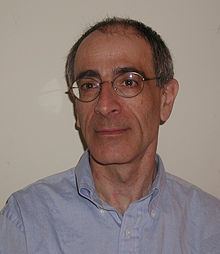Residence United States Name G. Clore | Nationality British Role Biophysicist | |
 | ||
Born June 6, 1955London, U.K. ( 1955-06-06 ) Institutions Fields Nuclear magnetic resonance, Biophysics, Structural biology | ||
Citizenship United States and U.K. Similar Mark Schena, Gilbert Chu, Steven Clarke | ||
G. Marius Clore FRSC (born June 6, 1955) is a British-born American molecular biophysicist and structural biologist. He was born in London, U.K. and is a dual US/U.K. Citizen. He is a member of the United States National Academy of Sciences, a NIH Distinguished Investigator, and the Chief of the Protein NMR Spectroscopy Section in the Laboratory of Chemical Physics of the National Institute of Diabetes and Digestive and Kidney Diseases at the National Institutes of Health. He is known for his foundational work in three-dimensional protein and nucleic acid structure determination by biomolecular NMR spectroscopy, for advancing experimental approaches to the study of large macromolecules and their complexes by NMR, and for developing NMR-based methods to study rare conformational states in protein-nucleic acid and protein-protein recognition.
Contents
Biography
Clore received his undergraduate degree with first class honours in biochemistry from University College London in 1976 and medical degree from University College Hospital Medical School in 1979. After completing house physician and house surgeon appointments at University College Hospital and St. Charles Hospital (part of the St. Mary's Hospital group), respectively, he was a member of the scientific staff of the Medical Research Council National Institute for Medical Research from 1980 to 1984. He received his PhD from the National Institute for Medical Research in Physical Biochemistry in 1982. He was awarded a Lister Institute Research Fellowship from the Lister Institute for Preventive Medicine which he held from 1982 to 1984 at the Medical Research Council. In 1984 he joined the Max Planck Institute for Biochemistry in Martinsried, Germany, where he headed the Biological NMR group from 1984 to 1988.
In 1988, Clore was recruited to the National Institutes of Health (NIH) Laboratory of Chemical Physics (National Institute of Diabetes and Digestive and Kidney Diseases) located in Bethesda, Maryland, where he interacted closely in the late 1980s and early 1990s with NIH colleagues Ad Bax, Angela Gronenborn and Dennis Torchia on the development of multidimensional heteronuclear NMR spectroscopy and a structural biology effort aimed at proteins involved in the pathogenesis of HIV/AIDS. He has remained at the NIH ever since and is currently an NIH Distinguished Investigator and Chief of the Section on Protein NMR Spectroscopy at the NIH. He is an elected Member of the United States National Academy of Sciences, a Fellow of the American Academy of Arts and Sciences, and a Foreign Member of the Academia Europaea (Biochemistry and Molecular Biology Section).
Research
Clore is known for the development of three- and four-dimensional NMR spectroscopy, the use of residual dipolar couplings for structure determination, the development of simulated annealing and restrained molecular dynamics for three-dimensional protein and nucleic acid structure determination, the solution NMR structure determination of large protein complexes, the development of the combined use of NMR and small-angle X-ray scattering in solution structure determination, and the analysis and characterization of protein dynamics by NMR. He is one of the main authors of the very widely used XPLOR-NIH NMR structure determination program, which evolved from the program X-PLOR developed by Axel Brunger and originally based on the program CHARMM-F that ran on Cray supercomputers. Clore's work on complexes of all the cytoplasmic components of the bacterial phosphotransferase system (PTS) led to significant insights into how signal transduction proteins recognize multiple, structurally dissimilar partners by generating similar binding surfaces from completely different structural elements and exploiting side chain conformational plasticity.
His recent work has focused on developing new NMR methods (such as paramagnetic relaxation enhancement, dark state exchange saturation transfer spectroscopy and lifetime line broadening) to characterize the structure and dynamics of sparsely-populated states of macromolecules, which are important in macromolecular interactions but invisible to conventional structural and biophysical techniques. Examples of recent work include the direct demonstration of rotation-coupled sliding and intermolecular translocation as mechanisms whereby sequence-specific DNA binding proteins locate their target site(s) within an overwhelming sea of non-specific DNA sequences; the detection, visualization and characterization of encounter complexes in protein-protein association; the analysis of the synergistic effects of conformational selection and induced fit in protein-ligand interactions; and the uncovering of "dark", spectroscopically invisible states in interactions of NMR-visible proteins and polypeptides (including intrinsically disordered states) with very large megadalton macromolecular assemblies. The latter includes an atomic-resolution view of the dynamics of the amyloid-β aggregation process.
Clore is one of the most highly cited scientists in the fields of molecular biophysics, structural biology, biomolecular NMR and chemistry with over 490 published scientific articles and an h-index (number of papers cited h or more time) of 126.
